For what feels like forever, Twin Citians have boasted — with justification — about the region’s quality of life.
The envied parks. The internationally influential arts institutions. The Fortune 500-heavy business climate. The healthy, well-educated and civically engaged populace.
To this we can finally add another bragging point: a dynamic and diverse food scene.
The evolution of the Twin Cities’ dining landscape is nothing short of revolutionary. But it didn’t happen overnight.
To mark the 50th anniversary of Taste — the section debuted in the Minneapolis Star on Oct. 1, 1969 — we are occasionally digging into its 2,500-plus past issues.
That takes us back to 2003, when we scrutinized the Twin Cities food scene for a story called “Two-Star Town.”
Sixteen years later, we’re back at it, enthusiastically raising that assessment to three stars. According to our restaurant rating system, that figure translates to “highly recommended,” and it represents a giant leap forward.
“The dining scene has greatly improved in the Twin Cities for many reasons,” said Jamie Malone, chef/owner of Grand Cafe and Eastside, both in Minneapolis. “Chefs and cooks celebrate a more collaborative spirit and happily share techniques and sources. But I think a lot of credit can go to our diners, who put their trust in us and are happy to try the things we are excited about.”
True, Minnesota doesn’t exist in a vacuum. “On a macro level, it’s changed nationwide,” said Russell Klein, chef/co-owner of Meritage in St. Paul. “You can now eat well in almost any major city in the country.”
But let’s face it: Milwaukee, Kansas City, Denver, St. Louis? They would kill to be us.
This exciting metamorphosis didn’t materialize out of thin air. The ground was laid, years ago, by visionary pioneers, including brothers Larry and Richard D’Amico (D’Amico Cucina, Campiello, Azur) and founders Phil Roberts and Pete Mijajlov of Parasole Restaurant Holdings (Manny’s Steakhouse, Pronto Ristorante, Figlio, Oceanaire Seafood Room).
The next generation took a different approach, propelling the food landscape forward in a big way.
“When Doug [Flicker] and I were starting out with our own restaurants, restaurants weren’t owned by chefs,” said Tim McKee, chef/owner of Octo Fishbar in St. Paul. “Chefs didn’t have access to capital. They didn’t have investors. We got the idea going in this market that chefs owned restaurants, and now, when you look at the restaurants that are making a difference in the culinary scene, they’re all chef-driven.”
At the same time, chefs were doubling down on crafting a cuisine that reflects the ingredients and traditions of this place, a farm-to-table movement fostered by Lucia Watson of Lucia’s Restaurant, Brenda Langton of Cafe Brenda (and now Spoonriver), Ken Goff of the Dakota Jazz Club & Restaurant and Lenny Russo of Heartland. Their traditions are being carried forward at the Birchwood Cafe, Wise Acre Eatery, the Bachelor Farmer, Restaurant Alma, Ngon Bistro, Common Roots Cafe, Town Talk Diner and Gastropub, and many others.
It helps that the metro area is surrounded by some of the nation’s most productive and progressive farmlands, a supply chain that’s the envy of chefs from coast to coast.
That proximity to quality — and quantity — certainly helps drive consumer local-foods gusto. Ten short years ago, there were 42 crop-sharing CSA (community-supported agriculture) programs in Minnesota; today, there are nearly 100.
Farmers markets have also taken root across the state, growing from 86 in 2007 to more than 190 today. In the metro area, farmers markets have become fertile breeding grounds for a long list of entrepreneurs who matriculated their outdoor outposts into brick-and-mortar operations, including the folks behind Sun Street Breads, Bogart’s Doughnut Co., Gorkha Palace and Foxy Falafel.
Do we even know how fortunate we are? For example, as Southeast Asians began to migrate here in the 1970s and 1980s, pho, bánh mì and other unfamiliar fare became as ubiquitous as wild rice, walleye and other taken-for-granted favorites.
Restaurants have always been on the front lines of the melting pot in this country. Twin Cities diners can circumnavigate the globe several times over and never leave the seven-county metro area. Culinary traditions spanning every continent — Indonesia to India, Morocco to Mexico, Somalia to Singapore — are represented here in restaurants and markets, a breadth and depth unimaginable 20 years ago. It’s an impressive feat, especially when considering the region’s relatively homogenous racial and cultural climate.
Thanks to television and a food-obsessed segment of social media, diners have also become more engaged, and more discerning.
“Our strong economy, well-traveled public and a genuine curiosity for something other than meat and potatoes launched us to the next level over the course of the last decade,” said Jack Riebel, chef/co-owner of the Lexington in St. Paul.
Those rising expectations have led to improvements across the board. Look at our professional sports stadiums, our airport and even our parks. All are national food-and-drink role models. Even the Minnesota State Fair, that reliable barometer of populist tastes and the state’s largest open-air food court, has been experiencing a pronounced uptick in quality and ingenuity.
Our hotels, too. There was a time when the St. Paul Grill was the region’s only well-regarded hotel restaurant. Today, more-than-decent restaurants are requisite components of any self-respecting Twin Cities hotel, including Tullibee at the Hewing Hotel, Giulia at the Emery hotel, Mercy at Le Méridien Chambers and Lela at the Sheraton in Bloomington. Even Restaurant Alma, one of the city’s top-rated restaurants, got into the act and now operates its own (small) hotel.
But think about it: It’s all better here food- and drink-wise compared with 15 or 20 years ago. Better coffee. Better ice cream. Better bread. Better beer. Better vegetarian and vegan fare.
Even better restaurant-centric neighborhoods, where dining has transformed our urban geography.
Witness the North Loop, arguably the Twin Cities’ dining epicenter. Fifteen years ago, the area was starting to make the transition from industrial to commercial/residential. Today, the neighborhood’s thousands of residents can walk to a quartet of four-star restaurants — Demi, Spoon and Stable, the Bachelor Farmer and Bar La Grassa — as well as a bevy of talked-about dining destinations, from Smack Shack and Sweet Chow to Kado No Mise, Red Rabbit and Freehouse.
Another contributing factor: There are more restaurants than ever before, but there are also more people living in the Twin Cities than at any other time. The metro area’s population grew by 265,000 since 2010, according to the Metropolitan Council. If those quarter-million new residents are dining out once a week, they’re pumping the demand for 14 million additional restaurant meals into the dining economy each year.
In the end, this exciting transformation is driven by people.
Chefs. Restaurateurs. Bartenders. Bakers. Cooks. Servers. Sommeliers. Managers. Farmers. Entrepreneurs. And consumers, supporting this ever-growing, ever-improving culinary ecosystem.
““We elevate and support each other. We all love good food and great dining experiences, and it’s so inspiring to see people you love and respect taking this city to new levels.” — Michelle Gayer, Salty Tart former chef/owner
Basking in a bakery boom
Those with a sweet tooth have been treated to the best
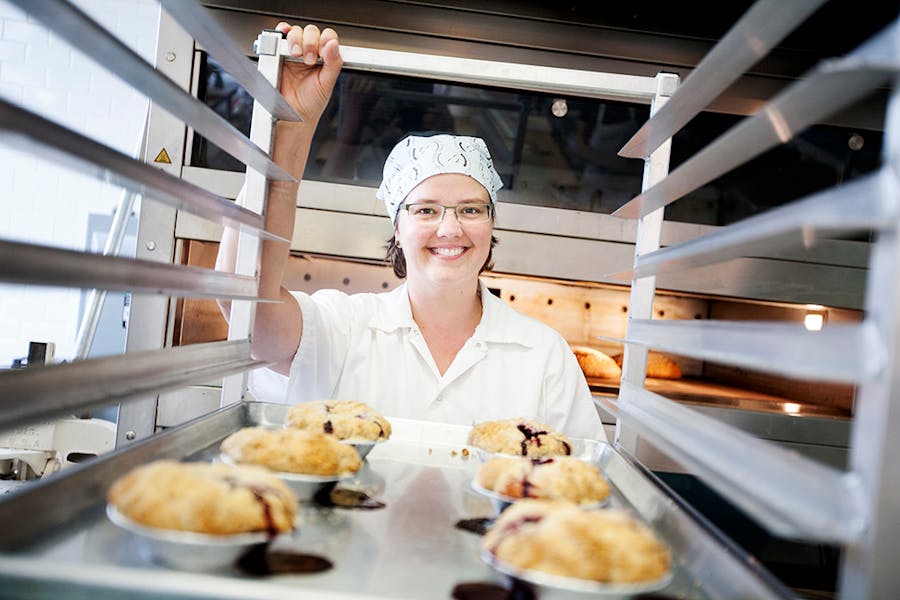
Solveig Tofte at Sun Street Breads in Minneapolis. Courtney Perry, special to the Star Tribune.
The Twin Cities has had a landscape-altering number of impressive bakeries materialize in the past 15 years. Can you imagine living here without the advent of Aki’s BreadHaus, Amy’s Cupcake Shoppe, Angel Food Bakery + Donut Bar, Augustine’s Bar & Bakery, Bellecour, Brake Bread, Cocoa & Fig, the Cookie Cups, Cossetta Pasticceria, Dulceria Bakery, Honey and Rye Bakehouse, Nadia Cakes, Que Viet, Patisserie 46 and Rose Street Patisserie, PieCaken, Rustica, Salty Tart, Savory Bake House, Sift Gluten Free, Something Sweet by Maddie Lu and Sun Street Breads?
(And this doesn’t include the bakery stands that pop up at farmers markets and festivals, including Asa’s Bakery, Solomon’s Bakery, Bakery Box, Wicked Tarts and High Five Bakery, among others.)
There are more on the horizon, including a permanent home for Sarah Botcher’s Black Walnut Bakery, opening in Uptown later this year.
Let’s not overlook the doughnuts! We’ve been immersed in a fried dough renaissance, thanks to Bogart’s Doughnut Co., Cardigan Donuts, Glam Doll Donuts, Hans’ Bakery, Mojo Monkey Donuts, Sleepy V’s, SugaRush, Thirsty Whale Bakery and YoYo Donuts & Coffee Bar.
Tracing it back to Tim McKee
The master has proven to be a noteworthy mentor
Probably more than any other Minnesotan, Tim McKee can be linked to a wide swath of the Twin Cities area’s contemporary food scene.
After all, a long list of now-notable chefs have been mentored in his kitchens, especially at the former La Belle Vie in Minneapolis, which closed in 2015 and remains a high-water mark in local fine dining. And through his work as a vice president of the Fish Guys, McKee is strengthening the connections that local chefs are making to seafood purveyors around the globe. His past-and-present employee roster is an A-list fellowship that fans out across the Twin Cities area, with each acolyte improving the dining culture at every turn. It’s quite a legacy.
“It’s humbling, and amazing,” McKee said. “I love seeing what people have accomplished. That’s one of the things that I’m most proud of.”
McKee’s past-and-present employee roster is an A-list collection that includes:



The deep bench
The next generation of culinary leaders learns from the best
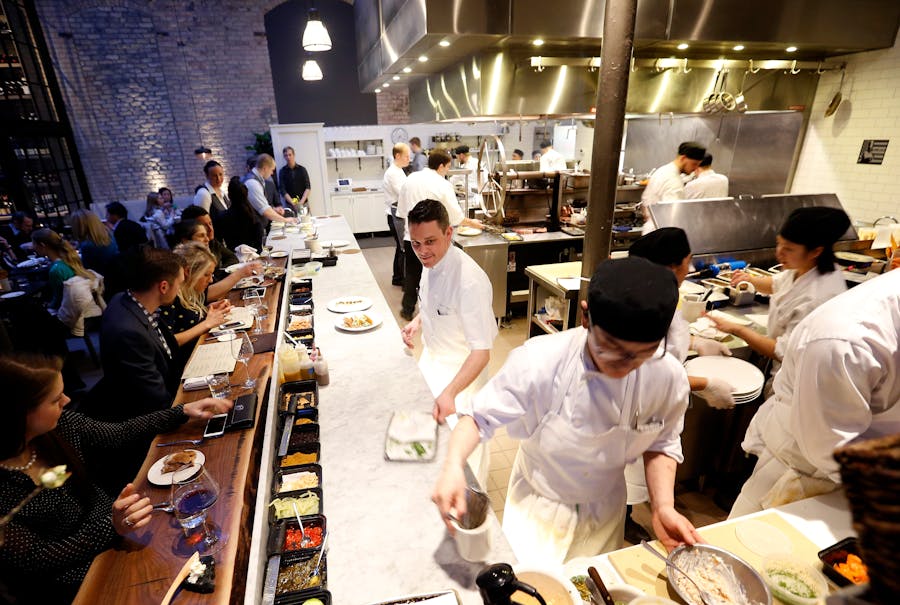
Chef and owner of Spoon and Stable Gavin Kaysen (middle) worked in the kitchen. Carlos Gonzalez, Star Tribune.
Great restaurants are fertile breeding grounds for more great restaurants. Which is why another encouraging signal for our dining future is the high-performing level of talent at work in the kitchens of the city’s name-brand chefs, a next-generation list of culinary leaders that includes Lucas Rosenbrook at Restaurant Alma, Jeff Lakatos at In Bloom, Chris Nye at Spoon and Stable, Laurence Herbert at Bellecour, Adam Ritter at Demi, Jonathan Seltvedt at 112 Eatery, Aaron Slavicek at Bar La Grassa, Ben Pichler at Burch Restaurant, Jason Engelhart at Meritage, Britt St. Clair at Grand Cafe, Ryan Cook at Eastside, Wyatt Evans at P.S. Steak and Shane Oporto at Octo Fishbar.
In a similar vein, there’s never been a better time to save room for dessert, thanks to the precipitous rise in the number of gifted practitioners conjuring up magic with flour, sugar and butter in top Twin Cities restaurants, including Diane Moua at Spoon and Stable, Bellecour and Demi; Carrie Riggs at Restaurant Alma and Cafe Alma; Emily Marks at the Bachelor Farmer; and Jo Garrison at P.S. Steak.
And we are fortunate enough to be living — and drinking — during what can only be described as a golden age of cocktails, thanks to the spirited, innovative efforts of Robb Jones at Spoon and Stable, Bellecour and Demi; Marco Zappia at Martina and Colita; Birk Grudem at Hai Hai and Hola Arepa; Matthew Voss at Marvel Bar; Adam Gorski at Young Joni; Jonathan Janssen at Lat14; Sean Jones at Fhima’s Minneapolis; and Jasha Johnston at Nightingale.
There are also the influential consultants who are making the marks at cocktail haunts across the Twin Cities: Jesse Held, formerly of Parlour and Constantine and now running his own show at Earl Giles; Nick Kosevich and Ira Koplowitz of Bittercube; Dan Oskey of Tattersall Distilling; and Erik Eastman of Easy & Co.
““I think the biggest difference in the last decade is diversity. The emergence of women and minority chefs ... who have been working hard for the last decade — are now starting to have their actions seen and their voices heard.” — Doug Flicker, Bull's Horn Food & Drink and Sandcastle
Bringing home Beard
Six chefs represent the best in the Midwest
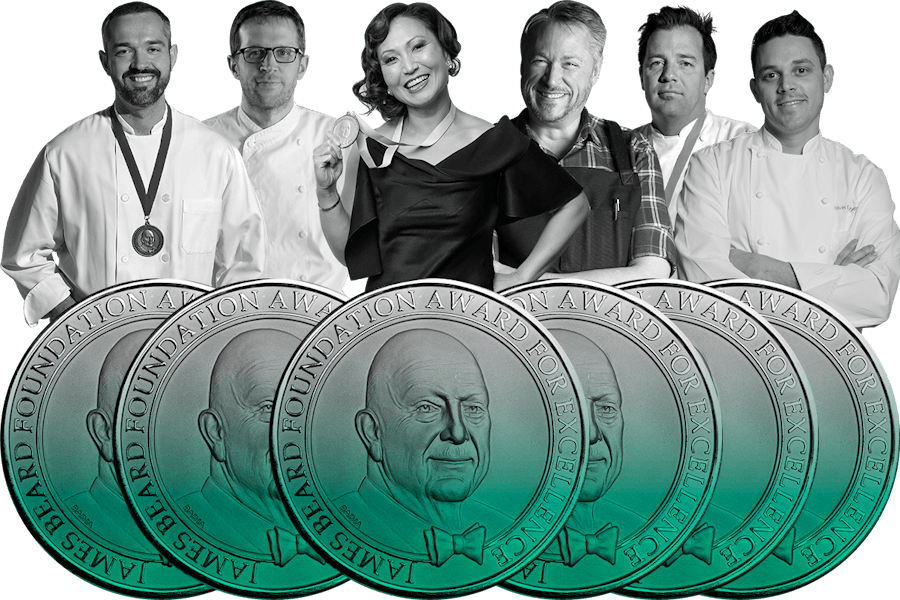
From left: Alex Roberts, Paul Berglund, Ann Kim, Tim McKee, Isaac Becker and Gavin Kayson.
The James Beard Foundation in New York City started handing out awards for excellence in 1991, and they quickly became the highest honor of America’s culinary world.
It took 18 years for a Minnesota chef to win a coveted Beard medallion, when Tim McKee, then of La Belle Vie (and now at Octo Fishbar), was named Best Chef: Midwest.
Since then, that same annual award has been bestowed upon five other Minnesotans: Alex Roberts of Restaurant Alma (2010), Isaac Becker of 112 Eatery (2011), Paul Berglund of the Bachelor Farmer (2016, and now at Fiddleheads Coffee in Rochester), Gavin Kaysen of Spoon and Stable (2018) and Ann Kim of Young Joni (2019).
In the past decade, these six chefs have made the Twin Cities the Midwest’s most awarded destination. It’s a winning streak that outdistances any other city that falls within the Best Chef: Midwest orbit, which covers Minnesota, Wisconsin, Missouri, Iowa, Kansas, Nebraska, North Dakota and South Dakota.
The foundation also recognizes excellence on a national level, but the Twin Cities metro area has come home empty-handed in those categories. True, in 2008, Gavin Kaysen was named the foundation’s Rising Star Chef of the Year — given to chefs ages 30 and younger from across the country — but at the time he was cooking at Cafe Boulud in New York City.
Even local nominations in these rarefied national categories are few and far between. Only two Twin Cities chefs have received nominations on a national level, and both were for Outstanding Pastry Chef: Michelle Gayer of the Salty Tart in 2010, and Diane Moua of Spoon and Stable in 2018. Spoon and Stable was up for two in 2015: Best New Restaurant, and Outstanding Restaurant Design, via Minneapolis-based Shea Design. Now that Minnesota is dominating the regional Midwest category, when will a Twin Cities chef or restaurant take home one of those national Beard awards?
(It’s not that the state isn’t on the Beard’s radar in other ways. The foundation’s cherished “America’s Classics” status was bestowed upon Al’s Breakfast and Kramarczuk’s, an award that pays tribute to “restaurants with timeless appeal and that are beloved for quality food that reflects the character of their community.” Wayne Kostroski, co-owner of Franklin Street Bakery, was named the foundation’s 2010 Humanitarian of the Year for his hunger relief work with Taste of the NFL, and the foundation’s 2019 Leadership Award was bestowed upon Sean Sherman of the Sioux Chef.)
They like us; they really like us
National publications shout the praises of Twin Cities food
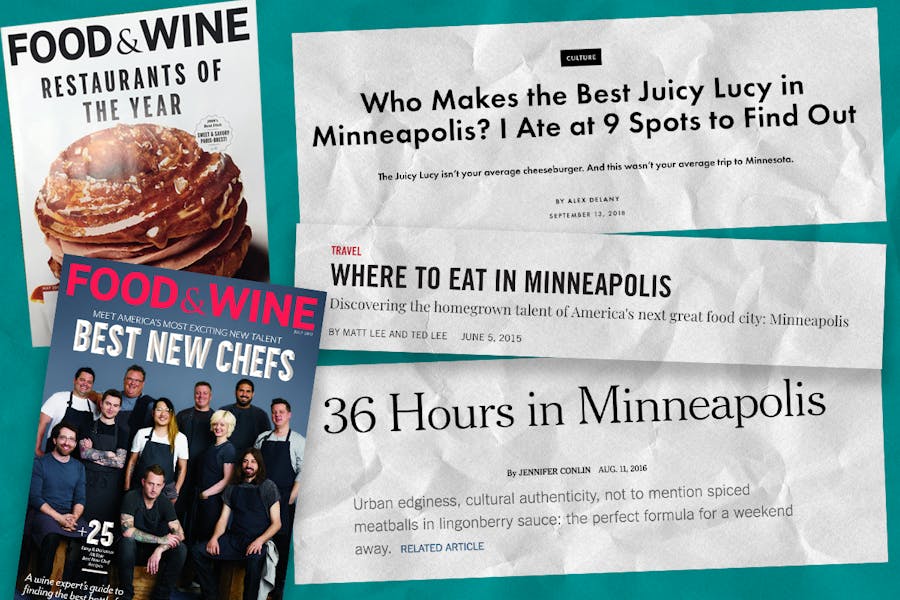
National tastemakers have been paying attention to the Twin Cities.
The New York Times, GQ and other national tastemakers have made a hobby of heaping all kinds of attention and adulation on the Twin Cities food scene.
“We were floored by how Minneapolis was inspiring excitement about Midwestern food the way Nashville was Southern food,” reads a particularly enthusiastic rave, from Saveur magazine in 2015, which dubbed Minneapolis “America’s next great food city.”
One gauge is the number of Twin Cities chefs who have found themselves on the cover of Food & Wine magazine’s Best New Chefs issue since 2005, including Jim Christiansen (the former Heyday), Jamie Malone of Grand Cafe (during her Sea Change tenure), Stewart Woodman (the former Heidi’s, now with Food Trip Foods) and Seth Bixby Daugherty (during his time at Cosmos, now at Seven).
But let’s just focus on 2018, when the lovefest went on, and on. “It’s snowing and 10 degrees outside and there’s never been a better time to head to Minnesota,” gushed Food & Wine in January. Four months later the glossy named Grand Cafe one of the country’s 10 best new restaurants, and awarded its dish of the year accolades on chef Jamie Malone’s savory Paris-Brest, splashing it across the magazine’s cover. In August, F&W singled out Spoon and Stable as one of the 40 most important restaurants of the past 40 years.
In May, Far & Away, a joint effort between National Geographic and the Wall Street Journal, crowned Minneapolis-St. Paul “America’s coolest drinking city.” In November, Esquire magazine showered all kinds of love on the metro area, naming Hai Hai one of the country’s 20 best new restaurants, and christening chef/co-owner Christina Nguyen its rising star of the year. The magazine also bestowed beverage director of the year honors on Marco Zappia of Martina and restaurant resurrection of the year on Grand Cafe.
On the web, Eater, the national dining-focused website, hailed Spoon and Stable as one of America’s 38 essential restaurants and Hai Hai as one of the nation’s 18 best new restaurants. Even non-foodie titles got in the act. In June, People magazine highlighted the skills and creative chops of two Twin Citians: Michelle Gayer of the Salty Tart and Diane Moua of Spoon and Stable and Bellecour. In December, Us Weekly magazine crowned Hai Hai, Spoon and Stable and Bellecour as three of the nation’s 100 best restaurants.
Even this month’s Bon Appétit joined the conversation, raving about how diners “can take a world tour without leaving Minnesota” in an enthusiastic spread that guides readers on a travelogue from Kurdistan (Babani’s) to Scandinavia (Fika) to Somalia (Quruxlow).
Starry, starry restaurants
Excellence in local dining has improved dramatically
The escalating number of four-star restaurants is a definite measure of improvement. In the 20 years that the Star Tribune has conducted a four-star rating system, 24 establishments have been awarded the top rank (“Extraordinary”) of four stars. Fifteen remain open, although five are operating under different chefs and/or owners.
Concerned about the closure rate? No need. A 2014 study, conducted by statisticians at the U.S. Bureau of Labor Statistics and the Department of Statistics at the University of California, Berkeley, took a deep dive into two decades of census data and determined that the median life span of an independently owned full-service restaurant is 4.5 years.
Another factoid: According to the study, 17% of restaurants close in their first year. That’s a far cry from the 50% figure that’s commonly invoked, and it’s lower than the 19% first-year closing rate for other service businesses.
““Barriers to entry are lower and there are more opportunities to try new ideas — food trucks, neighborhood restaurants, pop-ups — it is not an easier busiess than it used to be, there are just more opportunities to get started.” — Patti Soskin, Yum! Kitchen and Bakery
Blooming in the ’burbs
You can find excellent food outside the city limits
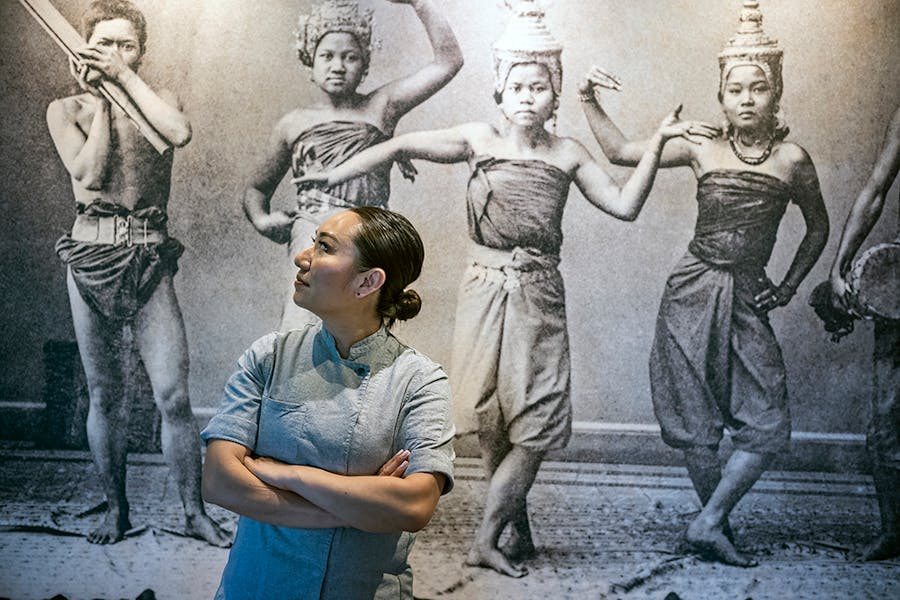
Ann Ahmed is the Lat14 chef/owner of her stylish restaurant in Golden Valley. The name is inspired by the geographical latitude of the cuisine of Southeast Asia. Richard Tsong Taatarii, Star Tribune.
Since nearly three-quarters of Twin Citians reside outside the city limits of Minneapolis and St. Paul, the logic would follow that the suburbs would be packed with stellar, singular restaurants. Not so, at least not on a per capita basis. But over the past decade, the ’burbs have become fertile ground for savvy restaurateurs, who have followed some pioneers (I Nonni and Campiello, for starters) into boosting the dining prospects from Wayzata to Woodbury.
No one has done more to readjust the suburban mind-set than Travail Kitchen & Amusements. The four-star rule-breaker, led by chefs James Winberg, Bob Gerken and Mike Brown, has made an art form out of blowing up the tasting menu format. Constantly in a state of reinvention, the restaurant (and its neighboring offshoot, Pig Ate My Pizza) is undergoing yet another incarnation, in a sleek new home that’s under construction across the street from the current downtown Robbinsdale location. Look for a fall opening.
Gavin Kaysen chose the site of a 1970s suburban fine-dining pinnacle, the former Chouette in Wayzata, for his Bellecour, an affectionate and beautifully managed homage to the classic cooking of Lyon, France, home to his two mentors, Daniel Boulud and the late Paul Bocuse.
Co-owner John Serrano may have started his Punch Pizza in St. Paul’s Highland Village neighborhood more than 20 years ago, but the company’s greatest expansion efforts have made standard-setting Neapolitan pizza available to the hungry denizens of Eden Prairie, Wayzata, Woodbury, Maple Grove, Vadnais Heights, Eagan and now Roseville.
Gleaning experience from her Lemon Grass Thai Cuisine in Brooklyn Park, chef/owner Ann Ahmed has embraced a wider, more daring range of Southeast Asian flavors at her instantly popular Lat14 in Golden Valley. The stylish restaurant’s top-to-bottom transformation of a 1970s-era Perkins serves as a tedium-eliminating example to all suburban streetscapes.
Patti Soskin developed such an enormous following to the quick-service attractions of Yum! Kitchen and Bakery in St. Louis Park that she launched a second outpost in Minnetonka for her crowd-pleasing tuna melts, chicken noodle soup and coconut layer cake.
Richfield wasn’t exactly on the culinary map when Restaurant Alma vet Benjamin Rients launched his spirited Lyn 65 in 2014, but he and chef Dan Manosack have made Lyndale and 65th a destination.
Noted cookbook author Raghavan Iyer lives in downtown Minneapolis, but he chose Eden Prairie for Pizza Karma, where showy tandoor ovens bake naan-like flatbreads that are finished with an around-the-world array of toppings. It’s located in the same strip mall as one of the metro area’s great Indian restaurants, India Spice House.
Acqua offers serious Italian cooking and hospitality in White Bear Lake, chef Alex Dayton is focusing on pizza and pasta at the Dough Room in Wayzata, Manger recently opened in Bayport and Thirty Bales finds inspiration in local, seasonal ingredients in a former sub shop in downtown Hopkins.
And the growth continues. Mon Petit Chéri has relocated its bakery/cafe format from Minneapolis to Stillwater. 6Smith owner Randy Stanley is building Baldamar, a contemporary steaks-and-chops shop, adjacent to Rosedale Mall in Roseville. And United Noodles has expanded into Woodbury with a retail store and prepared-foods counter.
New laws on the menu
Smoking bans, mobile kitchens and more have made a difference
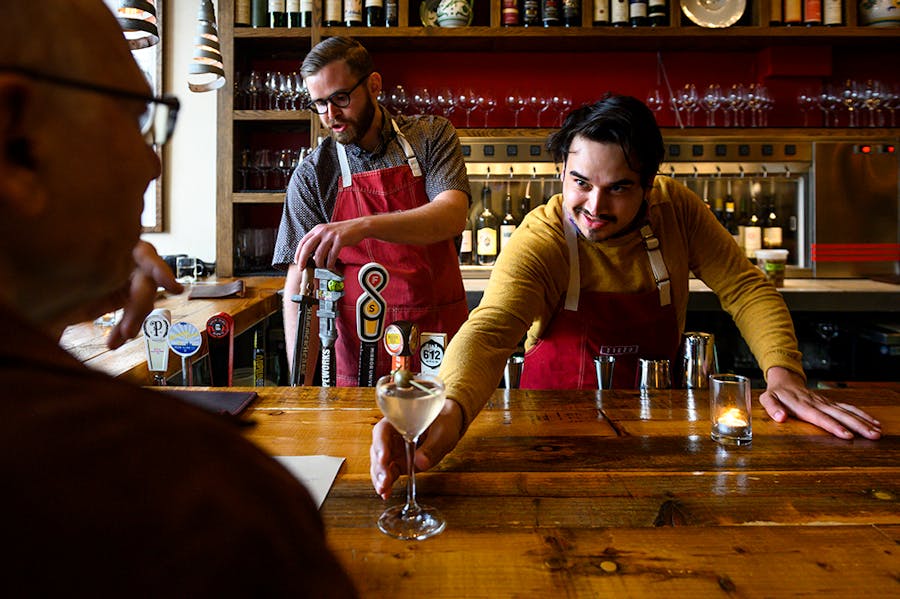
Terzo started serving cocktails in 2019. Here, bartender Bradley Sylte served up a dirty martini while colleague Eamon Whalen tended to a beer order.Aaron Lavinsky, Star Tribune.
These enlightened changes to laws have dramatically altered the local dining landscape.
Clearing the air: A 2007 statewide smoking ban swept a breath of fresh air — literally — into Minnesota’s dining and drinking environments. A restaurant boom followed — coincidence? — which happily included a burst of contemporary craft cocktail connoisseurship that started, pre-ban, with mixology savant Johnny Michaels at La Belle Vie, but went full-tilt with the advent of the influential Bradstreet Craftshouse in 2009.
Creating a street scene: When Minneapolis passed food truck-friendly ordinances in 2010, another new market segment took flight. Since then, more than 200 mobile kitchens have forged a remarkable street food scene, one that has spawned a flurry of exciting and influential brick-and-mortar restaurants, including World Street Kitchen, Hola Arepa, Smack Shack, Vellee Deli, Cafe Racer Kitchen, Bibuta, Green + the Grain, Foxy Falafel, DelSur Empanadas, Bark and the Bite, A Cupcake Social and Sassy Spoon.
Crafting a movement: Most of the 150-plus microbreweries that operate in Minnesota today owe their existence to 2011’s so-called Surly Bill, which eased taproom regulations and spurred a torrent of craft beer operations. The result is an animated beer-drinking culture, and a billion-dollar-plus boon to the state’s economy. A provision in that legislation also dropped the prohibitive licensing fee for distilleries, sparking a boom in spirits production and cocktail tasting rooms.
Saying “cheers” to cocktails: In the 2018 election, Minneapolis voters overwhelmingly approved an amendment to a 19th-century clause in the city charter, making it easier for neighborhood restaurants to obtain full-service liquor licenses. The switch followed a 2014 amendment that loosened another burdensome rule, one regarding food/alcohol sales ratios in restaurants. Both will encourage a more lively cocktail culture to sprout across the city (to date, nearly two dozen licenses from the 2018 amendment have been approved), and allow restaurateurs to capture more revenue.
Tackling minimum wage: Restaurateurs are coming to grips with changes in the minimum wage, particularly in Minneapolis, where a 2017 ordinance introduced graduated increases that currently run at $10.25 for many businesses and will culminate at $15 per hour by 2024. The impact is difficult to forecast: Will the city be overrun with quick-service and self-service formats, which have less expensive staffing demands?
The situation is complicated by the tip credit, which allows employers to pay tipped employees a lower minimum wage. The vast majority of states offer some variation on the tip credit, but Minnesota is one of seven that don’t. Some feel that the lack of a tip credit will be detrimental, as restaurateurs working in an industry known for tight margins will be forced to pass along higher labor costs to consumers, turning a $14 burger into, say, $17.
Yet viewed from a glass-half-full perspective, several other no-tip-credit states play host to some of the country’s hottest food scenes, including Los Angeles, San Francisco, Las Vegas, Seattle and Portland, Ore. (and several leading food cities, including Washington, D.C., have also adapted a graduated $15 minimum wage). One problem: These destinations are often propelled by free-spending tourism and convention traffic, attributes the Twin Cities lack.
And it could be argued that Minnesota’s aversion to the tip credit has prohibited a tsunami of cost-conscious national chains from flooding the state’s dining scene in Anywhere, USA, mediocrity. Stay tuned.
Hometown heroes
Experience in kitchens around the world has influenced local chefs
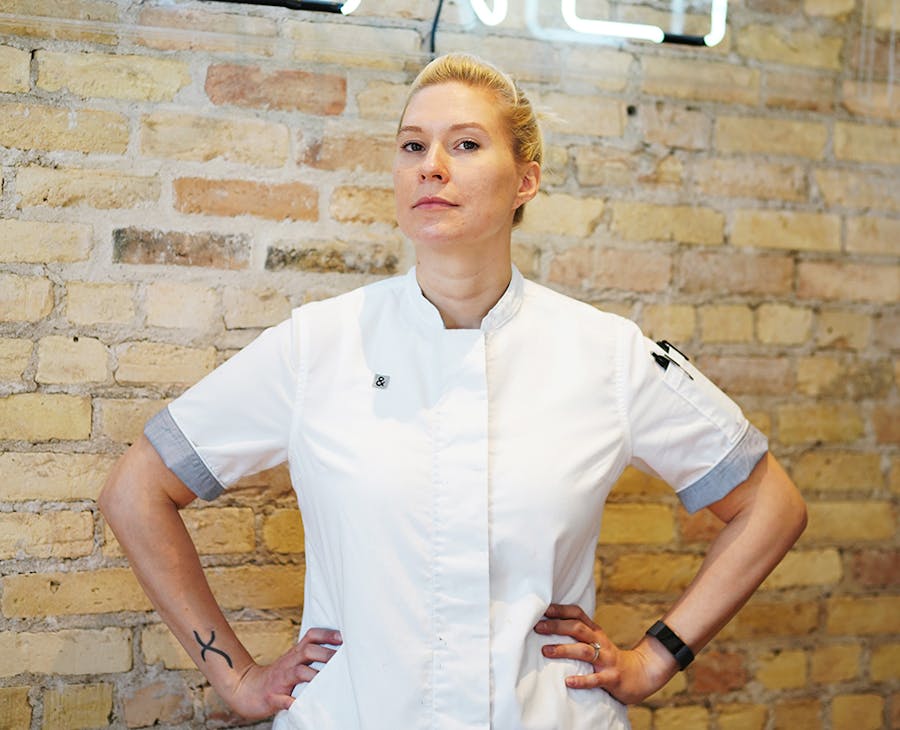
Chef Christina Kaelberer of Edwards Dessert Kitchen. Richard Tsong-Taatarii, Star Tribune.
Minnesotans who have trained elsewhere, and then returned to the Gopher State with a truckload of expertise, are playing an outsize role in the dining scene’s ascent.
Gavin Kaysen is, of course, the gold standard, a Bloomington native who cooked in Switzerland, London and San Diego before spending a decade with mentor Daniel Boulud in New York City. His return to the Twin Cities in 2014 triggered a seismic shift in the local dining scene. Over the course of five years he has launched a trio of four-star restaurants — Spoon and Stable, Bellecour and Demi — an unprecedented feat.
At his adventurous and artful Bardo in Minneapolis, Remy Pettus constantly demonstrates skills learned during his tenure in two highly influential kitchens: Chicago’s former Moto, which might have ranked as the nation’s most playful molecular gastronomy laboratory, and Charlie Palmer’s Dry Creek Kitchen in Napa Valley.
Waconia native Rikki Giambruno and Paul Baker of Mounds View didn’t know each other in Minnesota. They met while cooking at the well regarded Franny’s in Brooklyn, and they transferred that restaurant’s seasonal Italian framework back to St. Paul’s Grand Avenue to create Hyacinth.
Christina Kaelberer grew up in St. Louis Park and has baked in top kitchens on both coasts — most notably at New York City’s famed Rainbow Room — ideal know-how when it came to developing the Twin Cities’ first dessert-centric restaurant, Edwards Dessert Kitchen in the North Loop.
Before several productive years of bouncing around top kitchens in Philadelphia, Denny Leaf-Smith cooked at 112 Eatery and Cafe Lurcat; now he’s running Esker Grove at Walker Art Center, and it’s better than ever.
Stillwater native Matt Leverty spent a dozen years cooking his way through the Wolfgang Puck empire before taking the helm at Tullibee.
Red Rabbit chef Todd Macdonald grew up near Lake Harriet, and cooking in the kitchens of two James Beard award winners — Boston’s Ken Oringer and New York City’s David Bouley — played a priceless role in his career.
Between the two of them, Minnesota natives Lisa Carlson and Carrie Summer trained with a constellation of starry chefs in New York City, San Francisco and London, including Gray Kunz, Daniel Humm, Jean-Georges Vongerichten and Masaharu Morimoto. The innovative duo channeled that fine-dining knowledge into the Chef Shack — which jump-started the Twin Cities’ food truck scene — and now informs their day-trip destination in rural western Wisconsin, Chef Shack Bay City.
Although he was born in Minnesota, Thomas Boemer spent most of his youth in the South, where he acquired an affection for barbecue and traditional Southern fare. He cooked in Alain Ducasse’s high-end Mix in Las Vegas before returning to Minneapolis, where, in partnership with restaurateur and wine buff Nick Rancone, has realigned the Twin Cities dining scene with Corner Table, Revival and the extraordinary In Bloom, anchor of St. Paul’s Keg and Case Market food hall.
The latest example? Chef Erik Skaar, a Twin Cities native who cooked in top Denver and Seattle restaurants before returning here to create his intimate, Scandinavian- and seafood-focused Vann, opening in mid-July near the shores of Lake Minnetonka in Spring Park.
““Dining in the Twin Cities has improved due to availability of resources. And Gavin Kaysen. He has totally changed the game by bringing hands, eyes and bellies to Minneapolis-St. Paul, enriching the existing talent and giving hometown kids a reason to stay.” — Steven Brown, Tilia and St. Genevieve
Productive transplants
They bring a world of experience to the tables in the Twin Cities
Yes, we have a rich reservoir of locally nurtured culinary talent. But let’s not overlook how outsiders have cracked open this insular place with their smarts, creativity and fresh perspectives.
5,968 miles from Japan to Minneapolis
Sometimes they crossed an ocean. Witness Shigeyuki Furukawa, the chef/co-owner of Kado No Mise, a Japanese native bringing the exacting, multicourse kaiseki tradition to the North Loop.
5,913 miles from Buenos Aires to Minneapolis
Daniel del Prado grew up in Buenos Aires and infuses that city’s pulse into his energetic Martina and Colita. Another native of that city, Facundo Javier Defraia, is introducing Minnesotans to the empanada culture of his hometown at Boludo, all in Minneapolis.
1,927 miles from LA to Minneapolis
Born in Los Angeles and raised three hours south of Mexico City, Hector Ruiz now owns five Minneapolis restaurants: Cafe Ena, La Fresca, Rincón 38, Costa Blanca Bistro and Don Raul.
1,656 miles from Seattle to Minneapolis
At the Bachelor Farmer, Seattle native Jonathan Gans is applying the expertise he culled in some of his hometown’s top restaurants.
1,571 miles from Berkeley to Minneapolis
Steve Vranian spent 15 years working with Jeremiah Tower, one of the influential founders of the California cuisine movement, then introduced its emphasis on local, seasonal ingredients to a number of Twin Cities restaurants, including his current gig, Gianni’s Steakhouse in Wayzata.
1,196 miles from New York to St. Paul
When New Yorker Russell Klein landed in St. Paul, he adding luster to the city’s venerable W.A. Frost & Co. before opening Meritage with his spouse Desta Klein. Their oyster bar — and annual oyster festival — have made bivalves a menu requisite for Twin Cities restaurants.
408 miles from Chicago to Minneapolis
John Kraus came from Chicago’s French Pastry School to create Patisserie 46 and Rose Street Patisserie. Three years ago, Kraus was inducted into Relais Desserts, the first American admitted to the elite global conclave of 100 of the best of the best French pastry chefs.
Attracting more talent to the Twin Cities should be job No. 1 among civic boosters. But proceed with caution. It’s also worth noting that when chefs with national — and international — profiles have parachuted into the Twin Cities (Marcus Samuelsson at Aquavit, Wolfgang Puck at 20.21 and Jean-Georges Vongerichten at Chambers Kitchen) the restaurants didn’t last, suggesting that Twin Cities diners prefer locally rooted efforts rather than outposts rarely visited by their leadership.
Innovators at the forefront
From locally milled grains to little known liqueurs, entrepreneurship thrives
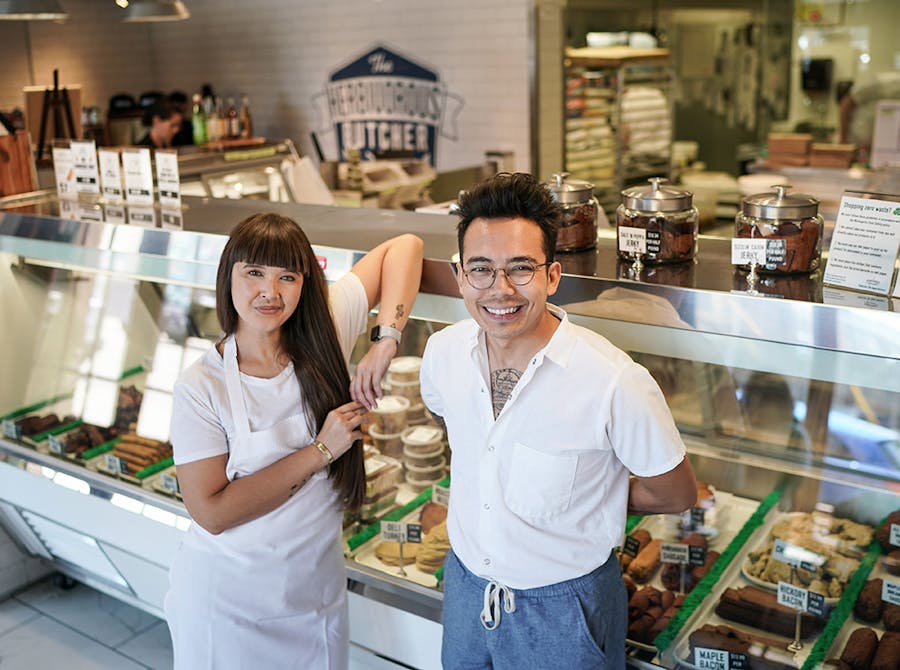
Herbivorous Butcher co-owners, and siblings, Aubry and Kale Walch. Glen Stubbe, Star Tribune.
Trailblazers have propelled the Twin Cities to the forefront of the national food-and-drink conversation.
When chef Mike Phillips created his Red Table Meat Co., he was turning an avocation into a vocation, producing some of the country’s most sought-after salami, mortadella, speck and ham.
Ironic that, in a city once known as the Flour Milling Capital of the World, Steve Horton had to lobby City Hall for a zoning change so he could stone-mill locally cultivated heritage grains. Those fresh flours are the foundation of naturally leavened breads — baked in a wood-fueled oven — at his remarkable Baker’s Field Flour & Bread.
(Both enterprises are located in the Food Building, which was created by former restaurateur Kieran Folliard to concentrate artisan food production under a single northeast Minneapolis roof. Alemar Cheese Co., one of the state’s top cheesemakers, is moving into the facility this summer.)
At the Herbivorous Butcher, siblings Aubry Walch and Kale Walch have created a national audience for their ever-expanding line of small-batch, plant-based replicas of meats, poultry, sausages, jerky and cheeses.
A transformative figure in the American cocktail universe works in Edina. He’s Eric Seed, owner of Haus Alpenz, and he scours the world for little-known liqueurs, aperitifs and aromatized wines, then spreads his “ambitious and adventurous palate” gospel among U.S. tastemakers.
Let’s not forget the University of Minnesota scientists responsible for introducing some of the country’s most popular cold-region fruits, including the Honeycrisp, SweeTango and Rave (aka First Kiss) apples, Summercrisp pears and Frontenac and Frontenac blanc grapes. And Marla Spivak and her colleagues at the U’s Bee Lab have placed a spotlight on the critical role that pollinators play in the world’s ecology.
Looking ahead
Here are 10 rising stars in the Twin Cities dining scene

1. José Alarcon left his native Mexico at age 19 and headed north, looking for work to support his family. Fifteen years later, he’s at the helm of two of the most dynamic Mexican restaurants to ever materialize in Minnesota, Popol Vuh and Centro.

2. Should she ever tire of running restaurants — that would be a dark day, indeed — Laurel Elm formerly of Saint Dinette, now at Restoration Hardware’s new Edina dining-shopping project — could teach a doctorate-level course on hospitality.

3. Dulce Monterrubio left a 13-year career in education to create Dulceria Bakery, jump-starting her business, as so many have before her, via a popular farmers market stand.


4-5. After converting their Hola Arepa food truck into a wildly successful brick-and-mortar operation, Christina Nguyen and Birk Grudem turned their attention and considerable skills to creating Hai Hai, resulting in a much-deserved avalanche of national accolades.

6. How fortunate we are to have Sean Sherman, aka the Sioux Chef, in our midst. When he opens his first restaurant next summer at Water Works, a new riverside park project in downtown Minneapolis, it will be among the first in the country to celebrate native foods.

7. The Twin Cities busiest culinary professional just might be Justin Sutherland. Fresh off his role in the most recent iteration of “Top Chef,” he’s leading the charge at a long list of St. Paul restaurants, including the Handsome Hog, Public Kitchen + Bar, Gray Duck Tavern and Green Lantern, and he’s reviving his former Pearl and the Thief in a new downtown Minneapolis address.

8. Karyn Tomlinson manages to thread both subtlety and panache into her exacting cooking at Corner Table, a dexterity best savored via one of the region’s most alluring dining deals, a $50 three-course dinner.

9. Will 2019 prove the year that Yia Vang finds a permanent home for his groundbreaking Union Hmong Kitchen pop-up business? Here’s hoping.

10. That we are in the midst of a barbecue boom is due in part to the craftsmanship and entrepreneurial drive of Jon Wipfli of Animales Barbeque Co.
““It used to be that if you wanted to get noticed in any way, and develop a reputation, it was through fine dining. Now you look at the restaurants that are really exciting, and they’re far more casual and accessible.” — Tim McKee, Octo Fishbar
The new standard-bearers
Expansion and reinvention, with their new challenges, reinvigorates these chefs
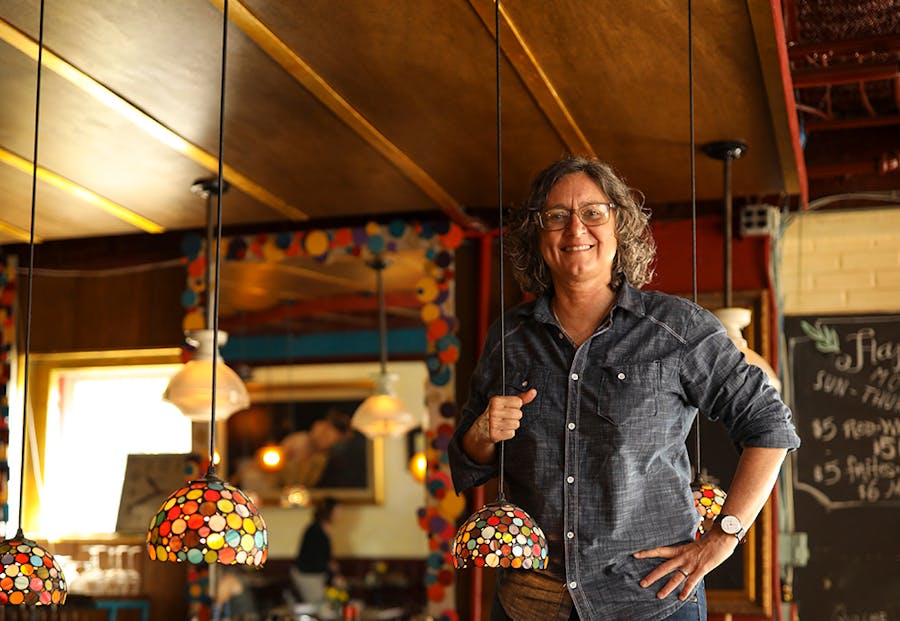
Restaurateur Kim Bartmann at Barbette in Minneapolis. Jeff Wheeler, Star Tribune.
Most members of what might be considered the region’s culinary neo Old Guard — a misnomer, since they’re hardly ancient — aren’t exactly resting on their laurels. They’re imbued with a constant sense of reinvention, and their leadership and innovation continue to enrich this community.
After closing La Belle Vie — and leaving his post with Parasole Restaurant Holdings, where he raised standards at the company’s popular restaurants — Tim McKee dove headlong into the rigors of seafood distribution with the Fish Guys. Then he converted the former Heartland into the Twin Cities’ most forward-thinking seafood restaurant, Octo Fishbar, carving out collaborative spaces for several partnerships, including a venue for Birch’s on the Lake to brew blood-orange Berliner Weiss and other beers that is a fastball’s throw from CHS Field and a retail counter space for both Peterson Craftsman Meats and Almanac Fish.
A few years shy of the 20th anniversary of Restaurant Alma (and having mastered the quick-service format with his Brasa), Alex Roberts took control of the entire building that had been the restaurant’s longtime home and built a casual, all-day eatery he christened Cafe Alma. He also added seven hotel rooms to the mix.
Isaac Becker — partnering, as always, with spouse Nancy St. Pierre — recently announced an addition to the 112 Eatery-Bar La Grassa-Burch Restaurant family, a pizzeria and lounge in the North Loop that’s set to open in late summer.
After taking on a consulting gig at Esker Grove, Doug Flicker closed his sublime Piccolo and turned his attention in the opposite direction, reinventing the classic corner bar with Bull’s Horn Food & Drink.
Steven Brown, of Tilia and St. Genevieve, collaborated (with chef Joshua Hedquist) on the menu at the just-opened Giulia, in the Emery hotel in downtown Minneapolis.
And restaurateur Kim Bartmann is expanding her impressive stable of nine restaurants (Barbette, Red Stag Supperclub, Pat’s Tap), adding a restaurant and coffee shop in the Mill District.
Culinary ambassadors
Explore the good fare of those with Minnesota connections
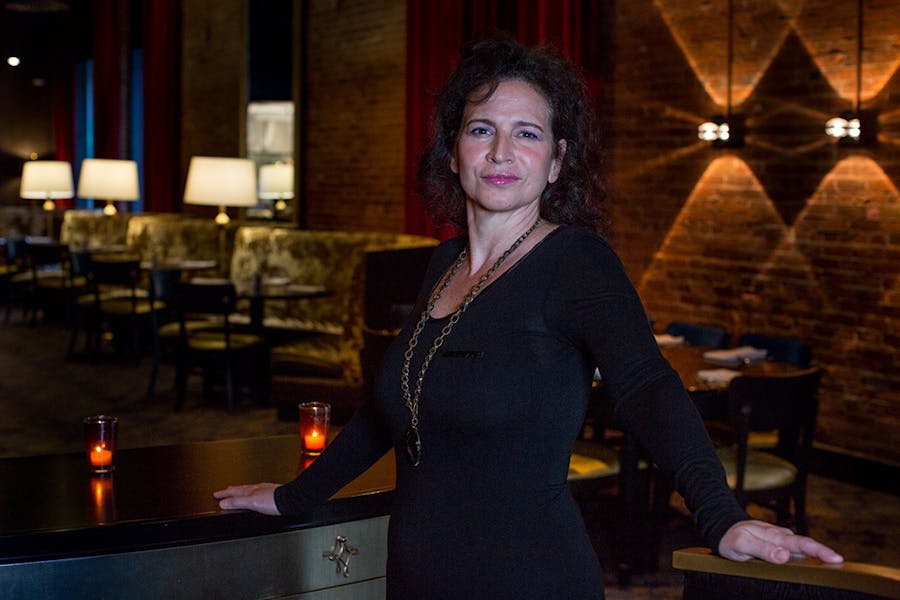
Lovechild co-owner Joan Ferris poses for a portrait inside the restaurant's dining room in La Crosse, Wis. Courtney Pedroza, Star Tribune.
Twin Cities chefs are spreading their know-how across the region, brightening the food fortunes of communities that are a convenient day trip away.
James Beard award-winner Paul Berglund, formerly of the Bachelor Farmer, is now in Rochester at Fiddlehead Coffee Co. After making a splash at Surly Brewing Co., Jorge Guzman is now lighting up the La Crosse Distillery in La Crosse, Wis., and influential D’Amico & Partners veterans Jay Sparks and Joan Ferris chose the same Mississippi River city for their superb Lovechild.
About a year after he closed Upton 43 in Minneapolis, Erick Harcey launched his remarkable Willards in Cambridge, Minn., and after presiding over a 10-year run at the Strip Club, J.D. Fratzke is taking on a food hall — Artisan Plaza — in Cannon Falls, Minn.
Widening the scope, Erik Anderson (formerly of Sea Change and the short-lived Scena Tavern) is now at San Francisco’s two-Michelin-star-rated Coi, and Nick Dugan has traded Bellecour for the dazzling Michael Mina in Las Vegas.
Then there are the raised-in-Minnesota chefs who are working elsewhere, including Plymouth native Jon Nodler; his Cadence in Philadelphia was just named the best new restaurant in the country by Food & Wine magazine. Or Ian Redshaw, who grew up in Waconia and owns a pair of well-regarded restaurants in Charlottesville, Va. All are doing Minnesota proud.
An encouraging change of careers
Plan B has worked out just fine for these restaurant folks
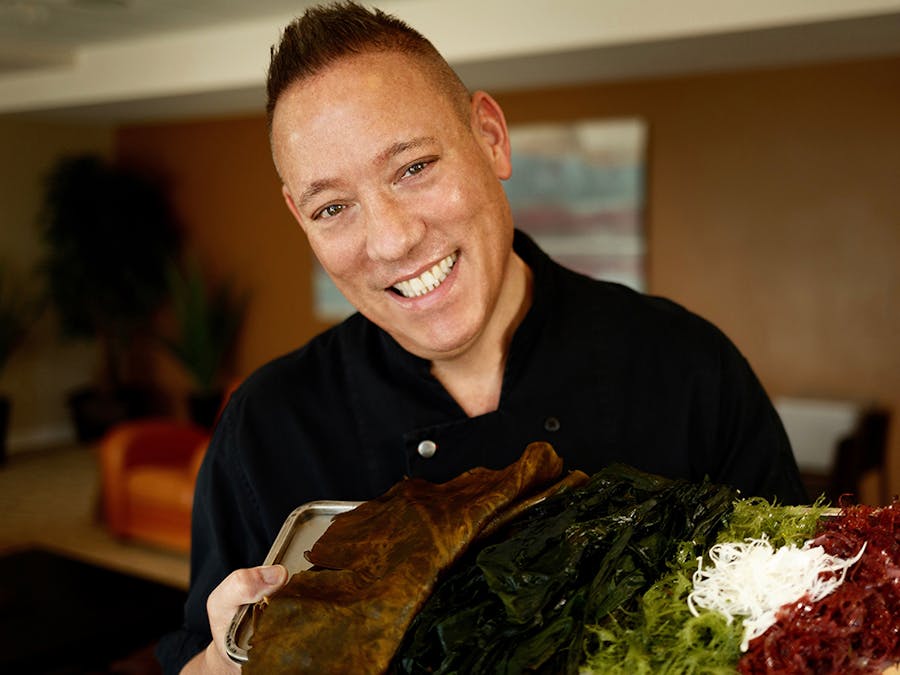
John Sugimura of PinKU Japanese Street Food. Dan West, special to the Star Tribune.
Continually filling the near-bottomless ranks of the dining industry has long fallen on young practitioners, a fact that’s at odds with the precipitous decline in local culinary education programs. Three schools — Art Institutes International, Le Cordon Bleu and the culinary arts program at the Minneapolis Community and Technical College — have closed in the past four years. Where will the next generation of leaders come from?
One encouraging source is the number of people who have chosen to leave a wide variety of professional pursuits in favor of following new careers in restaurants. The breadth and depth of their experience have proved to have a powerful effect on our dining scene.
Consider John Sugimura, who left a life in government service to open PinKU Japanese Street Food. Or Aki Berndt, the architect-turned-baker behind Aki’s BreadHaus. Or Anne Spaeth, an attorney-turned-restaurateur who spent 10 years planning for the Lynhall before making it a reality.
Or siblings Jen Lloyd and Kate Lloyd, who channeled a bagel obsession into Rise Bagel Co. Or Barb Zapzalka, who taught herself the intricacies of ice cream making (saying goodbye to her career as a systems analyst) and opened Pumphouse Creamery; her rhubarb ice cream is a transcendent June-in-Minnesota experience.
Then there’s Ann Kim. After devoting years to acting, she combined her storytelling acumen — and passion for bread dough — into Pizzeria Lola, Hello Pizza and Young Joni.


